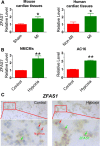LncRNA ZFAS1 as a SERCA2a Inhibitor to Cause Intracellular Ca2+ Overload and Contractile Dysfunction in a Mouse Model of Myocardial Infarction
- PMID: 29475982
- PMCID: PMC5959220
- DOI: 10.1161/CIRCRESAHA.117.312117
LncRNA ZFAS1 as a SERCA2a Inhibitor to Cause Intracellular Ca2+ Overload and Contractile Dysfunction in a Mouse Model of Myocardial Infarction
Abstract
Rationale: Ca2+ homeostasis-a critical determinant of cardiac contractile function-is critically regulated by SERCA2a (sarcoplasmic reticulum Ca2+-ATPase 2a). Our previous study has identified ZFAS1 as a new lncRNA biomarker of acute myocardial infarction (MI).
Objective: To evaluate the effects of ZFAS1 on SERCA2a and the associated Ca2+ homeostasis and cardiac contractile function in the setting of MI.
Methods and results: ZFAS1 expression was robustly increased in cytoplasm and sarcoplasmic reticulum in a mouse model of MI and a cellular model of hypoxia. Knockdown of endogenous ZFAS1 by virus-mediated silencing shRNA partially abrogated the ischemia-induced contractile dysfunction. Overexpression of ZFAS1 in otherwise normal mice created similar impairment of cardiac function as that observed in MI mice. Moreover, at the cellular level, ZFAS1 overexpression weakened the contractility of cardiac muscles. At the subcellular level, ZFAS1 deleteriously altered the Ca2+ transient leading to intracellular Ca2+ overload in cardiomyocytes. At the molecular level, ZFAS1 was found to directly bind SERCA2a protein and to limit its activity, as well as to repress its expression. The effects of ZFAS1 were readily reversible on knockdown of this lncRNA. Notably, a sequence domain of ZFAS1 gene that is conserved across species mimicked the effects of the full-length ZFAS1. Mutation of this domain or application of an antisense fragment to this conserved region efficiently canceled out the deleterious actions of ZFAS1. ZFAS1 had no significant effects on other Ca2+-handling regulatory proteins.
Conclusions: ZFAS1 is an endogenous SERCA2a inhibitor, acting by binding to SERCA2a protein to limit its intracellular level and inhibit its activity, and a contributor to the impairment of cardiac contractile function in MI. Therefore, anti-ZFAS1 might be considered as a new therapeutic strategy for preserving SERCA2a activity and cardiac function under pathological conditions of the heart.
Keywords: RNA, long noncoding; calcium; myocardial infarction; sarcoplasmic reticulum calcium-transporting ATPases.
© 2018 The Authors.
Figures






Comment in
-
Navigating the Sea of Long Noncoding RNAs: ZFAS1, Friend or Foe?Circ Res. 2018 May 11;122(10):1327-1329. doi: 10.1161/CIRCRESAHA.118.312964. Circ Res. 2018. PMID: 29748360 Free PMC article. No abstract available.
Similar articles
-
lncRNA-ZFAS1 induces mitochondria-mediated apoptosis by causing cytosolic Ca2+ overload in myocardial infarction mice model.Cell Death Dis. 2019 Dec 9;10(12):942. doi: 10.1038/s41419-019-2136-6. Cell Death Dis. 2019. PMID: 31819041 Free PMC article.
-
LncRNA CCRR maintains Ca2+ homeostasis against myocardial infarction through the FTO-SERCA2a pathway.Sci China Life Sci. 2024 Aug;67(8):1601-1619. doi: 10.1007/s11427-023-2527-5. Epub 2024 May 16. Sci China Life Sci. 2024. PMID: 38761356
-
Reduced sarcoplasmic reticulum Ca2+ pump activity is antiarrhythmic in ischemic cardiomyopathy.Heart Rhythm. 2022 Dec;19(12):2107-2114. doi: 10.1016/j.hrthm.2022.08.022. Epub 2022 Aug 24. Heart Rhythm. 2022. PMID: 36028211
-
Calcium-regulated transcriptional pathways in the normal and pathologic heart.IUBMB Life. 2011 Oct;63(10):847-55. doi: 10.1002/iub.545. Epub 2011 Sep 7. IUBMB Life. 2011. PMID: 21901815 Review.
-
Sarcoplasmic reticulum Ca2+-ATPase modulates cardiac contraction and relaxation.Cardiovasc Res. 2003 Jan;57(1):20-7. doi: 10.1016/s0008-6363(02)00694-6. Cardiovasc Res. 2003. PMID: 12504810 Review.
Cited by
-
Knockdown of ZFAS1 improved the cardiac function of myocardial infarction rats via regulating Wnt/β-catenin signaling pathway.Aging (Albany NY). 2021 May 5;13(9):12919-12928. doi: 10.18632/aging.202961. Epub 2021 May 5. Aging (Albany NY). 2021. PMID: 33952724 Free PMC article.
-
Expanding the horizon of EV-RNAs: LncRNAs in EVs as biomarkers for disease pathways.Extracell Vesicle. 2023 Dec;2:100025. doi: 10.1016/j.vesic.2023.100025. Epub 2023 May 20. Extracell Vesicle. 2023. PMID: 38188000 Free PMC article.
-
Long noncoding RNA NONMMUT015745 inhibits doxorubicin-mediated cardiomyocyte apoptosis by regulating Rab2A-p53 axis.Cell Death Discov. 2022 Aug 16;8(1):364. doi: 10.1038/s41420-022-01144-9. Cell Death Discov. 2022. PMID: 35974003 Free PMC article.
-
Targeting calcium regulators as therapy for heart failure: focus on the sarcoplasmic reticulum Ca-ATPase pump.Front Cardiovasc Med. 2023 Jul 18;10:1185261. doi: 10.3389/fcvm.2023.1185261. eCollection 2023. Front Cardiovasc Med. 2023. PMID: 37534277 Free PMC article. Review.
-
Calcium Signaling in Cardiomyocyte Function.Cold Spring Harb Perspect Biol. 2020 Mar 2;12(3):a035428. doi: 10.1101/cshperspect.a035428. Cold Spring Harb Perspect Biol. 2020. PMID: 31308143 Free PMC article. Review.
References
-
- Younce CW, Burmeister MA, Ayala JE. Exendin-4 attenuates high glucose-induced cardiomyocyte apoptosis via inhibition of endoplasmic reticulum stress and activation of SERCA2a. Am J Physiol Cell Physiol. 2013;304:C508–C518. doi: 10.1152/ajpcell.00248.2012. - PubMed
Publication types
MeSH terms
Substances
LinkOut - more resources
Full Text Sources
Other Literature Sources
Medical
Molecular Biology Databases
Research Materials
Miscellaneous

